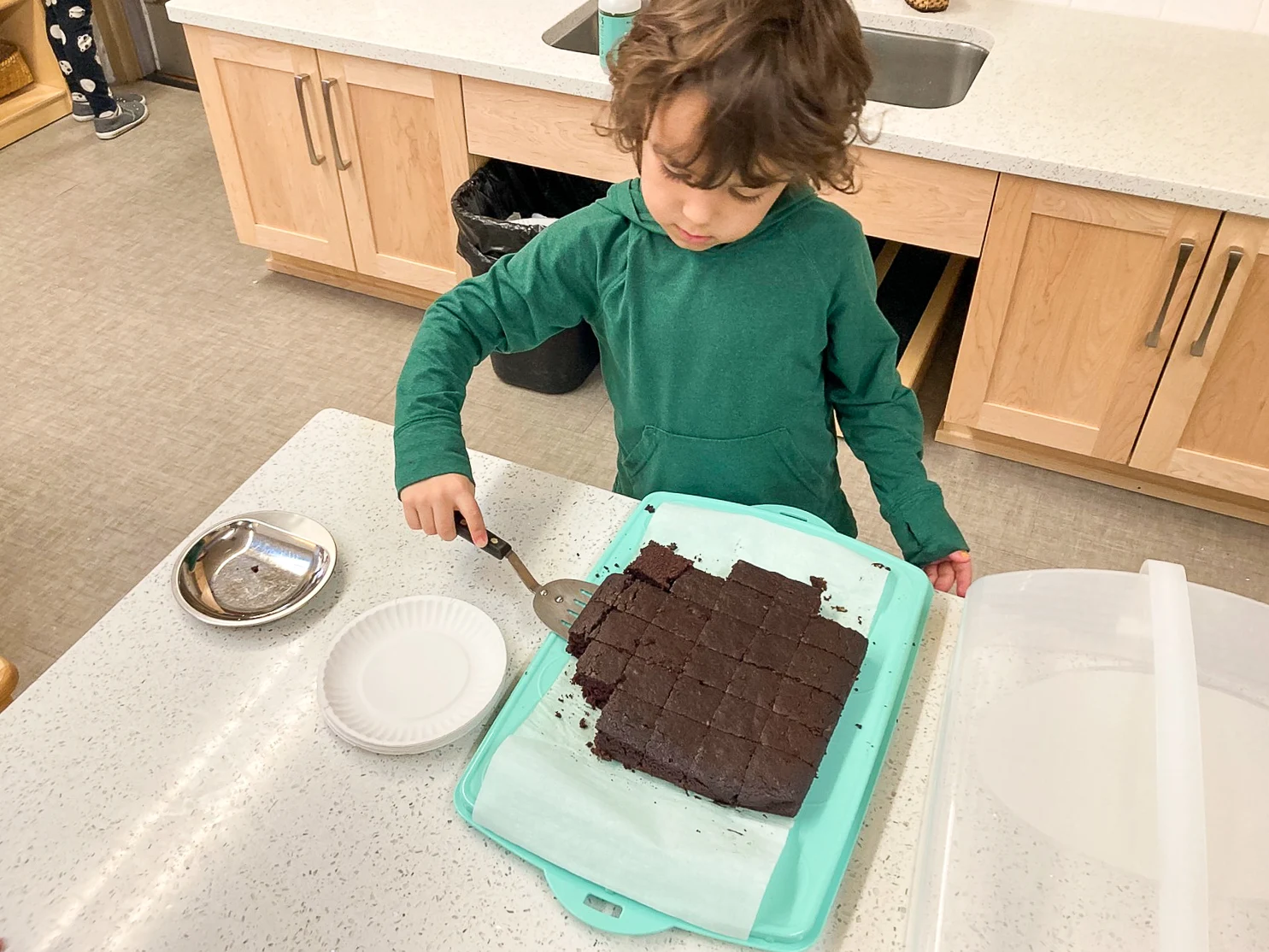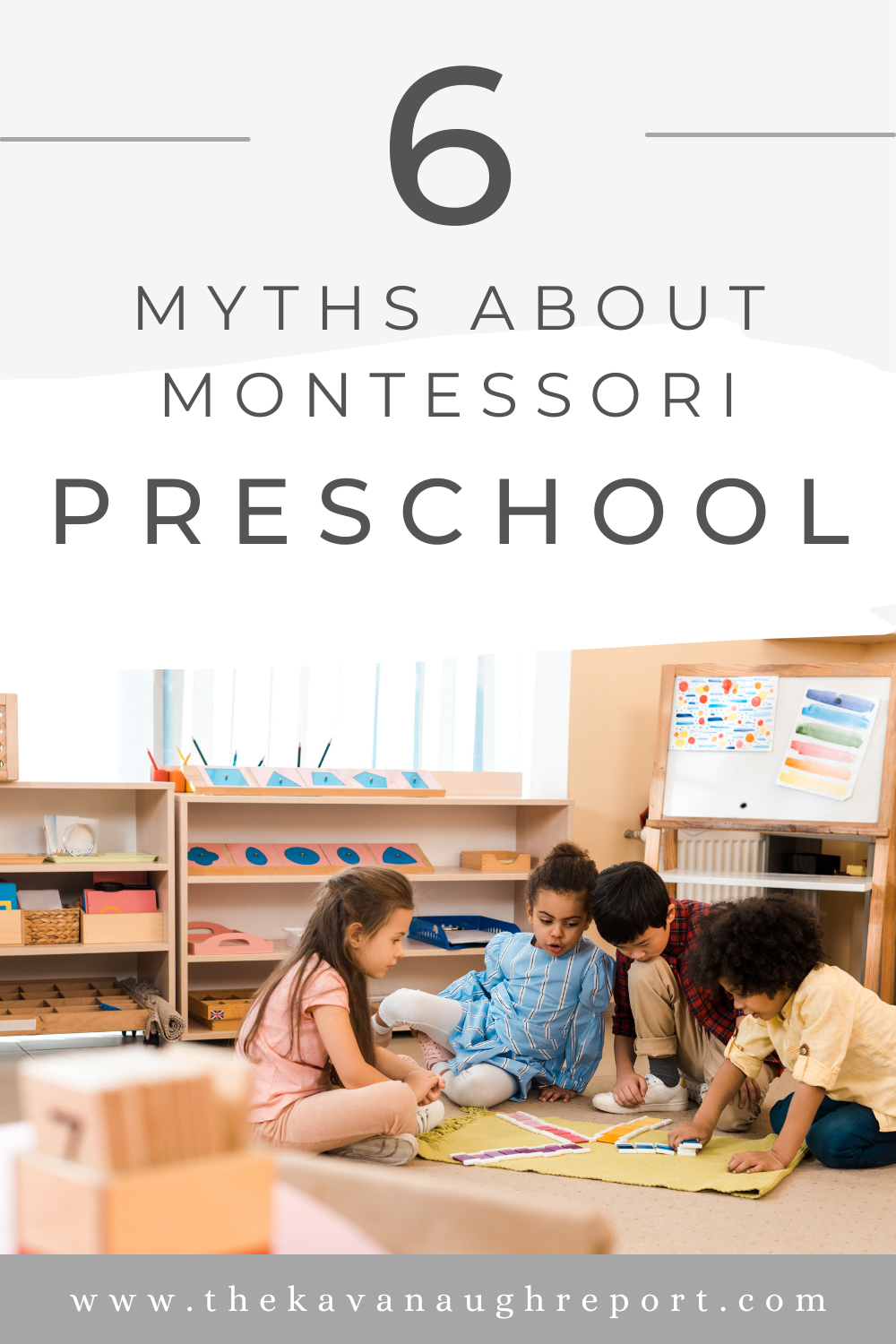As a Montessori parent, much of my life revolves around how I use Montessori principles to influence my home and parenting. But, I also love Montessori schools and the materials that Dr. Montessori created for children. At this point, three of my children attend Montessori schools full time and it's always my greatest joy to be able to get into the classroom and observe. Recently, I was able to observe in a Children's House classroom and it struck me how many myths about Montessori preschools were broken in even the short time I was there.
So, using my observations as a guide, I wanted to share six common myths about Montessori preschool and what I have observed instead. For context, you should know:
- This isn't the only time I've observed
- This observation was 30 minutes long
- This is Gus' (my kindergartener) classroom but he was sick that day
- Children's House (or sometimes called Primary) serves children from around 33m to 6-years
- Teddy (my 3-year-old) was with me
- The pictures in this post are random shots of Gus shared with me from the school throughout the year
Montessori Myth 1: Pretend Play Isn't Allowed
There is a prevalent myth that pretend play isn't allowed in Montessori preschools. But that isn't really true. Children pretend play all the time, no matter what. It is how they process their feelings and the world around them. While it is true you won't find dramatic play items in Montessori classrooms, pretend play is all around.
My observation: Three children gathered together at a small table and started chatting. They agreed that they wanted to play "kings and queens." They decided who would be who and stayed in these roles as they started labeling the environment (a writing/spelling work.) This game, the laughing, and the silliness continued for 25 minutes and was still going on as I finished my observation.
Montessori Myth 2: Montessori Pushes Early Academics
Some people feel like Montessori pushes young children toward math and language work too early instead of focusing on activities that would more traditionally be viewed as "play." Sometimes people can feel like Montessori preschools are a way to get an early jumpstart on academic learning.
My observation: The practical life area was the busiest part of the classroom while I was visiting. Children were busy with more practical and movement based work. Lots of children were making and eating snacks. The Montessori bells were very popular. Two children came to sit near me and both were working on various art/artistic expression work.
Montessori Myth 3: Montessori Preschoolers Work Alone or Mostly Alone
I think its common to look at pictures of Montessori children online and think that they are always working alone. No adult, no other kids - just quiet contemplation and deep concentration. Even the photos here make it seem that way (since I won't share pictures with other children.)
My Observation: This one really couldn't be farther from the truth. There were for sure a couple of kids that were working alone. One girl sat for a really long time working by herself. She was making designs on a piece of paper using the Montessori metal insets. Once she was done, she, so sweetly, walked to a friend and say "here, I made this for you." There were also one-to-one lessons being given by the guide. For example, one child worked with the assistant guide for a long time with the moveable alphabet spelling and sounding out words.
But, what was far more common was children buzzing around in community. Groups of twos and threes were very common. Two children eating snack. Two children following each other as they walked on the line. Three children labeling the environment. Kids would move from these groups to their own deeper work in a really beautiful way.
Montessori Myth 4: Montessori Preschools are for Quiet Kids
Again, I think that this myth comes from still pictures of Montessori preschool classrooms online. It's har to get a sense of how much action, community, and buzz there is around the room from these pictures. It sort of feels like everyone is just silently working in their own little table.
My Observation: The classroom was a buzz of activity, but also of noise. It wasn't overwhelming to me, but it was for neurodivergent Teddy. During my visit there was laughing, crying, chatting with adults, chatting with me, and chatting with each other. At one point the guide was working with a small group. They appeared to be playing a game where they tap out syllables in words around the room. As they played several more kids joined the game and eventually the whole little group was singing joyfully.
Again, the bells were used many times as well, adding beautiful little musical notes into the air!
Montessori Myth 5: Montessori Guides are Cold
I'm not sure where this myth comes from but it's one I've heard many times in my years working with parents in this community. It has never been my personal experience, but many people struggle with guides that seem more attached to the child in their album (training materials) than the child in front of them.
My Observation: This was simply just very untrue in my observation. Now, I'm admittedly biased here since these are my children's teachers and I've known the adults at this school since Nora started attending it nearly 6 years ago. But, I saw nothing but love. Children were hugged. Genuine interest was taken in their work, questions were asked and answered. Sometimes they just sat and observed something (the classroom seedlings were a common one) in silence. The guide (and other adults in the space) had a relationship and interacted with each child in a unique and personal way.
Montessori Myth 6: Montessori Preschools are too Rigid
There is also this idea that every child must be using Montessori materials exactly the perfect way or else everything is going to fall apart. I get this all the time from parents at home. That there is no room for creative expression, silliness, or straying from the presentation.
My Observation: I noticed that there are norms being followed in the classroom. For example, they are all moving chairs the same way. But, there was a lot of freedom within the limits of the classroom environment. Children were freely moving, wandering, talking and exploring. Then limits were set with care when necessary to help keep kids safe. At one point the children labeling the room wanted to label the ceiling. They were climbing into the reading loft and getting a little boisterous. A simple reminder was given that the reading loft was a quiet place. The kids weren't limited in their unique activity but the limits around that to keep everyone safe were clear.
Montessori schools vary significantly in their practice. Montessori is not trademarked so anyone can call themselves "Montessori." Getting into the classroom and really the best way to see the method in all it's beauty. So, I have no doubt that some of these Montessori myths have been truths in some Montessori schools with some Montessori guides. When you are considering a school, go observe and get a feel for the environment. If any of these myths is present, you may need to ask the school about it to get a clearer picture of what is happening.







